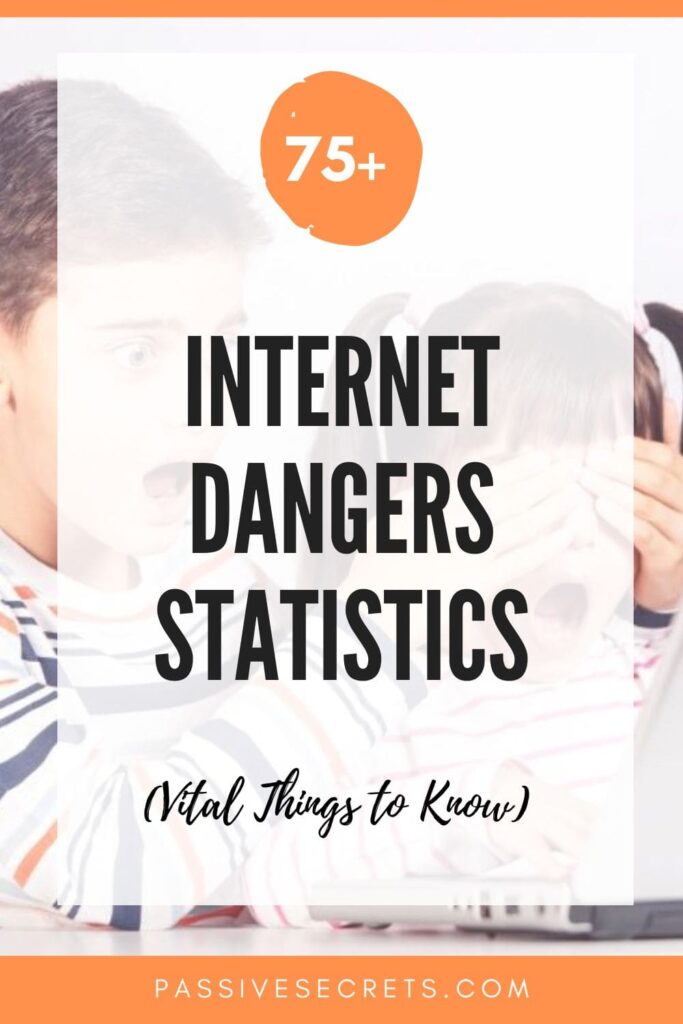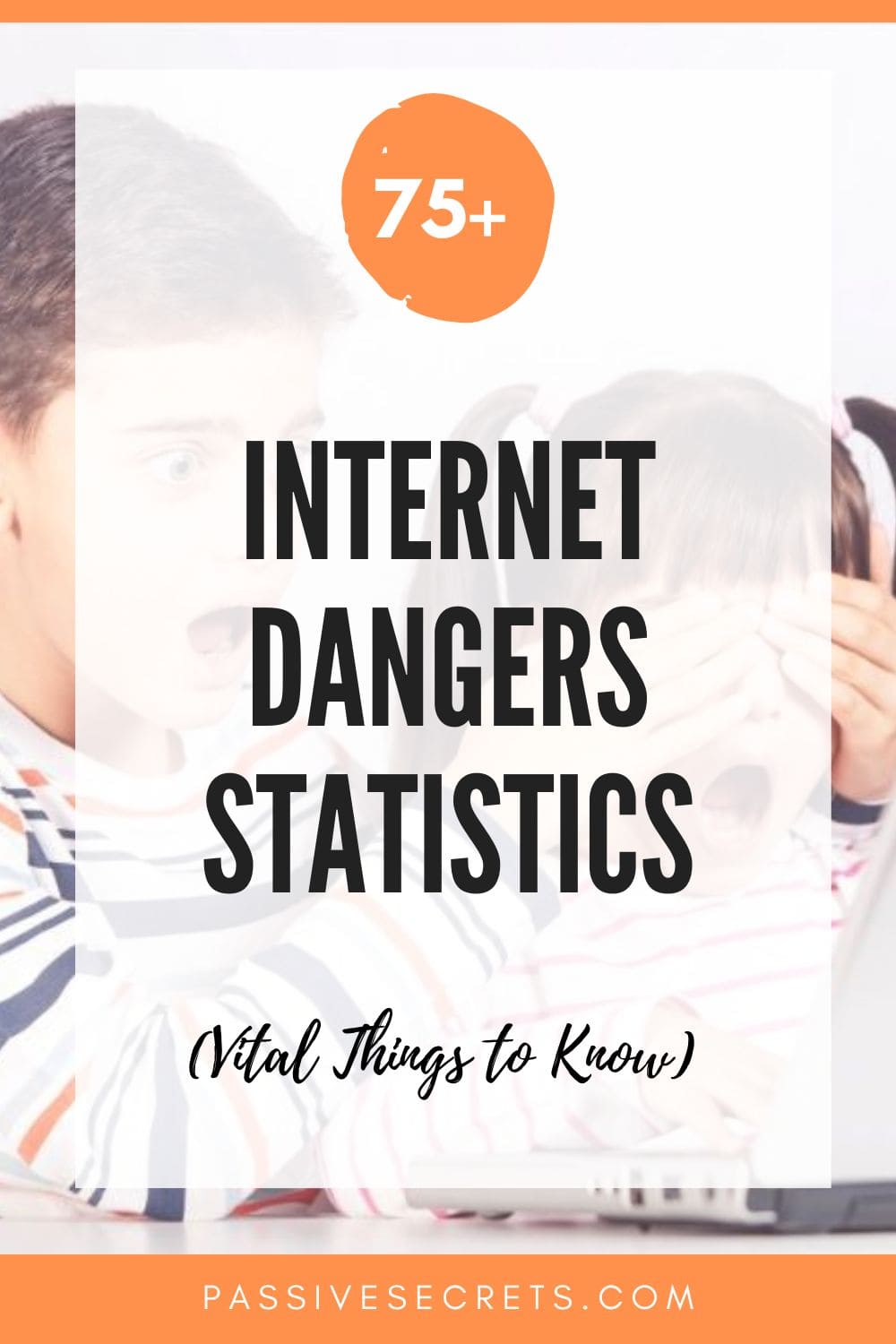
The Internet is man’s gift to humanity. We can admit we have learned a lot through the internet.
However, a popular saying goes, “Every good thing has a bad,” and I couldn’t agree more regarding the internet.
The internet has become a dangerous zone for many, especially for kids. And it seems it’s not getting any better.
To ensure you are safe and aware of what is happening, you should check out these thrilling internet dangers statistics.
The dangers of the internet keep growing, and these statistics show you what to look out for.
Key Facts: Internet Danger Statistics
- Every 39 seconds, an online attack takes place, and 1 in 7 children is contacted online by someone with sexual intentions.
- In 2021, businesses are projected to incur losses of over $20 billion due to ransomware attacks.
- Global Ransomware damage cost is set to exceed $265 billion by 2031.
- About 37% of young people between the ages of 12 and 17 have been bullied online.
- Every second, $190,000 is lost to cybercrime.
- The average cost of cybercrime for an organization is $13 million.
- 43% of cyberattacks target small businesses, but only 14% are prepared to defend themselves.
- 37% of the students report experiencing cyberbullying in their lifetimes.
General Internet Dangers Statistics
1. Every day, 230,000 new malware samples are created. (source)
2. 53% of internet users, or more than half, worry about protecting their online privacy. (source)
3. In 2022, there were 1,829 reported cyber incidents in the financial industry worldwide, down from 2,527 in the preceding year. (source)
4. Every 39 seconds, an online attack occurs. (source)
5. A research study shows that cyberbullying is the most common internet danger for kids worldwide. (source)
6. Around 81% of Americans express concerns regarding companies collecting private data. (source)
7. 12 million children are exposed to cyber risks, 9 million are affected by cyberbullying, and 6 million experienced cyber threats in the US only. (source)
8. Older adults lost $3.1 billion to internet scams in 2022, the most of any age group. (source)
9. Over 340 million new user registrations are leaked because of data breaches this year. (source)
10. 73% of organizations have been affected by DDoS attacks. (source)
11. A survey by Egress has revealed that an overwhelming 94% of organizations have experienced insider data breaches in the last year. Human error was the top cause of serious incidents, according to 84% of IT leaders surveyed. (source)
12. About three billion phishing emails are sent every day. (source)
13. Identity theft is the most common type of data breach, accounting for 59% of all breaches. (source)
14. It took an average of 206 days to identify a data breach in 2019. (source)
15. In the first week of 2024, there were over 612 new common IT securities and vulnerabilities and exposures (CVE). The total number discovered in 2023 was 29,000. This was the highest annual figure recorded so far. (source)
16. The cost of ransomware attacks grew to $20 billion in 2021. (source)
Ransomware is a popular malware that millions of computers and mobile devices around the world. It restricts these devices from accessing files and threatens to destroy vital data unless people pay a ransom permanently. Ransomware is popular among cybercriminals. And a Ransomware attack most likely occurs every 11 seconds.
17. The global Ransomware damage cost is set to exceed $265 billion by 2031. It is also regarded as the fastest-growing type of crime, as it is expected to attack a business every 2 seconds by 2031. (source)
18. Ransomware had about 4368 victims in 2023. This is the highest recorded number of victims so far. The same report shows that the number of victims in Q2 and Q3 alone was more than the total number of victims in 2022. (source)
19. As the United States is the most targeted region for ransomware attacks, the business sector is the most targeted sector. (source)
Internet Dangers Statistics For Kids And Teenagers
20. Nearly half (49%) of teens claim their parents do nothing to monitor their devices. (source)
21. 70% of children 7 to 18 years old have accidentally encountered online pornography, often through a web search while doing homework. (source)
22. 9.95% of tweens and 20.54% of teens encountered predatory behaviors from someone online. (source)
23. Approximately 89% of sexual solicitation of youth was made in chat rooms or through instant messaging. (source)
24. “86% of the girls polled said they could chat online without their parent’s knowledge, 57% could read their parents’ e-mail, and 54% could conduct a cyber relationship”. (source)
25. Law enforcement officials estimate that as many as 50,000 sexual predators are online at any given moment. (source)
26. 65% of all parents and 64% of all teens say teens do online things they wouldn’t want their parents to know about. (source)
27. An estimated 725,000 children have been aggressively asked for sex, defined as an offer to meet in person. (source)
28. 20% of the estimated 24 million children now online have been solicited for sex in the last year. (source)
29. 44% of teens admitted they’d watched something online their parents would disapprove of. (source)
30. Only 15% of parents are “in the know” about their kids’ social networking habits and how these behaviors can lead to cyberbullying. (source)
31. 77% of the targets for online predators were age 14 or older. (source)
32. Girls are more likely than boys to be the target of cyberbullying. (source)
33. 28% of teens have experienced multiple types of cyberbullying. (source)
Internet Dangers Statistics: Cyberbullying
34. 37% of young people between the ages of 12 and 17 have been bullied online, and 30% have had it happen more than once. (source)
35. In the previous 30 days, about 1 in 4 middle and high school students reported experiencing cyberbullying. (source)
36. 41% of Americans report being the victim of online harassment. (source)
37. 92% of Americans think cyberbullying is a problem. (source)
38. 3 in 4 cyberbullying targets were harassed on Facebook. (source)
39. Cyberbullying may be contributing to the increase in youth suicides. (source)
40. 42% of U.S. teens report that they experience offensive name-calling online. (source)
41. 24% of teenagers from a household earning less than $30,000 a year say they experience physical threats online. (source)
42. 12% of teenagers from a household earning $75,000 or more say the same. (source)
43. 37% of the students report experiencing cyberbullying in their lifetimes, according to a 2019 study. (source)
Internet Dangers Statistics: Social Media Dangers
44. Approximately a quarter (25%) of social media users have shared sensitive data online. (source)
45. 42% of youngsters experience cyberbullying on Instagram. (source)
46. The most popular site for cyberbullying is Facebook, with 27% of young people surveyed experiencing cyberbullying on the platform, followed by Snapchat with 21%. (source)
47. 24% have had private or embarrassing info made public without permission. (source)
48. 29% have been stalked or contacted by strangers or someone they don’t know. (source)
49. 12% of teens say they witnessed unpleasant behavior “frequently” on social networking sites. (source)
50. 15% of social media-using teens say they have been the objective of online meanness. (source)
51. 88% of teenagers have seen someone be mean or cruel to another person on a social networking website. (source)
52. 29% of Internet sex crime relationships were initiated on a social networking site. (source)
53. The number of sexual assault cases related to social media sites has increased by 300%. (source)
54. Teenage girls who excessively use social media are more prone to depression. (source)
55. 40% of girls who spend over five hours daily on social media platforms such as Instagram, Facebook, and WhatsApp display symptoms of depression. (source)
Statistics On Internet Dangers Trends
56. An estimated 33 million households pay for antivirus software. (source)
57. Approximately 85% of adult Americans believe that having antivirus software on their computers is beneficial. (source)
58. According to 81% of parents, online safety features are valuable tools for protecting their kids. (source)
59. Parents of younger children ages 6-12 were much more likely than parents of teens to use platform-based safety tools and used 4.4 tools compared to parents of teens. (source)
60. Anti-virus software is typically installed on personal computers, accounting for 85% of the usage. Mobile phones account for 24%, and tablets for 17%. (source)
61. According to Norton Lifelock, More than two-thirds of adults are conscious of their data. They put safety precautions in place as a result of this concern. (source)
Internet Dangers Cybercrime Statistics
62. The global indicator ‘Estimated Cost of Cybercrime’ in the cybersecurity market was forecast to increase continuously between 2023 and 2028 by $5.7 trillion. (source)
63. The cybersecurity market’s indicator, ‘Estimated Cost of Cybercrime,’ has continuously increased over the past few years. (source)
64. The average cost of cybercrime for an organization is at $13 million. This is an increase of $1.4 million from the previous years. (source)
65. In the last 12 months, 39% of UK businesses identified a cyber attack, remaining consistent with previous years. (source)
66. Investment fraud, with an average loss per victim of $70,811, was the most costly type of cybercrime in 2022. (source)
67. In the Asia-Pacific area, cybercrime rose by 168% between May 2020 and May 2021. (source)
68. Cyber Criminals have laundered over $4 billion in Bitcoin through ransomware extortion. (source)
69. Every second, $190,000 is lost to cybercrime, and the situation became more dire during the COVID-19 pandemic. (source)
70. The number of cybercrimes reported has surged by 300%, and it is projected that worldwide cybercrime will cost $10.5 trillion by 2025. (source)
71. The oil firm Colonial Pipeline was targeted by the Russian cybercrime group DarkSide on April 29, 2021, and they demanded a $4.4 million ransom in exchange for 100 gigabytes of stolen data. (source)
72. Compared to other nations, the UK and the USA have a disproportionately higher number of cybercrime victims per million internet users. (source)
73. Between 2001 and 2021, cybercrime took the lives of at least 6.5 million victims and is believed to have cost the economy close to $26 billion. (source)
74. According to the US government, there were nearly twice as many healthcare breaches in the first five months of 2022 as in the same period in 2021. (source)
75. According to a U.S. Internet Crime Complaint Center report, phishing is the most common type of cybercrime. It has had over 300,000 victims in 2022. In fact, 85% of surveyed organizations worldwide admitted to encountering Bulk Phishing. Additionally, 3 in 4 organizations say smishing scams targeted them. (source)
76. 43% of cyberattacks target small businesses, but only 14% are prepared to defend themselves. (source)
Final Thought
The statistics on internet dangers paint a concerning picture of the online landscape.
From cyberbullying to cybercrime, the data underscores the pervasive threats that individuals and organizations face.
Every 39 seconds, an online attack occurs, and 1 in 7 children is contacted online by someone with sexual intentions.
Businesses are projected to incur losses of over $20 billion due to ransomware attacks, and in 2022, total losses of $10.3 billion were reported due to internet crime.
These statistics highlight the importance of staying informed and taking precautions to ensure online safety.
By being aware of the risks associated with online activities and implementing robust cybersecurity measures, individuals and businesses can work towards creating a safer and more secure online environment.
FAQs On Internet Dangers Statistics
1. How Often Do Hacker Attacks Occur?
Hacker attacks occur frequently, with an average of one attack every 39 seconds globally.
2. How Prevalent is the Use of Social Media by Cyberstalkers to Gather Information About Potential Victims?
Up to 82% of cyberstalkers use social media to gather information on their targets.
3. How Many Teens Admit to Hiding Their Search History From Their Parents or Guardians?
70% of teens admit to hiding their online behavior from their parents or guardians. They use various methods to do so.
These methods include:
- Clearing their browser history (53%)
- Hiding or deleting instant messages or videos (34%)
- Using an Internet-enabled mobile device (21%), and
- Using privacy settings to make content viewable only to friends.
4. What Percentage of Tweens Report Receiving Uncomfortable Messages Online?
Approximately 17% of tweens have reported receiving uncomfortable messages online.
5. What Percentage of Children are Likely to Have Encountered Pornographic Material Online by the Age of 15?
Approximately 70% of teens aged 15 to 17 have reported accidentally encountering pornography on the internet.
6. How Many Young People Have Experienced Cyberbullying?
According to a report from the Pew Research Center, the prevalence of cyberbullying among young people is significant. The report found that 59% of U.S. teens have personally experienced at least one of six types of abusive online behaviors. Another report from the same source in 2022 revealed that, in total, 28% of teens have experienced multiple types of cyberbullying.
7. How Often is Malware Delivered via Email?
Malware is frequently delivered via email. According to various sources, 92-94% of all malware is distributed through emails, making it a common and effective method for cyber attacks. Phishing emails, designed to trick users into downloading malware, have become more sophisticated over the years, contributing to the high percentage of malware delivered via email.
8. Best Internet Danger Safety Measures?
To protect yourself and your family from internet dangers, you can follow these measures:
- Avoid oversharing online, especially your personal information
- Check if the sites you are visiting are secure
- Back up your data
- Use 2-factor Authentication (2FA)
- Be careful when connecting free WiFi hotspots
- Use a VPN, especially when traveling
- Don’t open random links
- Set up parental control for kids
- Install the latest software updates

Other Statistics Posts:
- 50+ Vital Internet Safety Statistics & Facts You Must Know
- 160 Holiday Spending Statistics 2024: Valentine’s Day, Easter, Thanksgiving, and Christmas
- 70 Exciting Love Statistics And Facts (True Love, Intimacy, Marriage, Dating & Relationships)
- 63 Change Management Statistics You Can’t Miss in 2024
- 52 Video Game Addiction Statistics You Should Know In 2024
- Amazon Book Sales Statistics
- 50+ Latest Life Coaching Statistics and Trends in 2024
- 73 Revealing Workplace Distraction Statistics [2024]
- 47+ Important 4-day Work Week Statistics [2024]
- 71 Important Workplace Communication Statistics To Know in 2024
- 45+ Important Communication Skills Statistics & Trends for 2024
- 35 Important Public Speaking Statistics To Help You in 2024
- 36 Interesting Social Worker Burnout Statistics for 2024
- 40+ Top Workplace Conflict Statistics You Should Know In 2024
- 54 Insightful Call Center Statistics for 2024
- 54 Incredible Goal Setting Statistics To Help You In 2024
- 55+ Useful Black Consumer Spending Statistics (2024 Report)
- 40+ Useful Procrastination Statistics To Help You In 2024
- 65+ Impressive Chess Statistics and Facts To Know in 2024
- 25+ Best Emotional Intelligence Statistics to Know in 2024
- 20 Crucial Body Language Statistics To Know In 2024
- 68 Performance Management Statistics & Trends in 2024 (Full Report)

